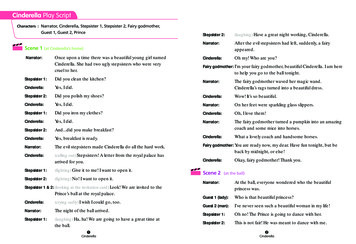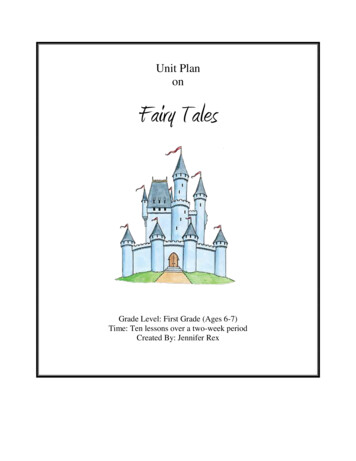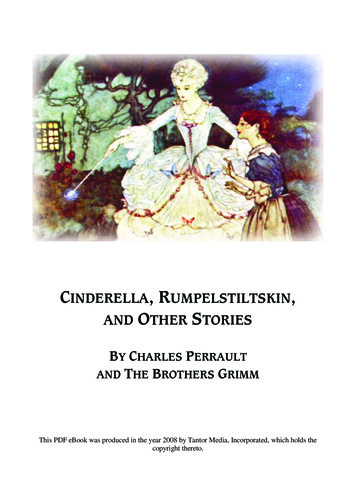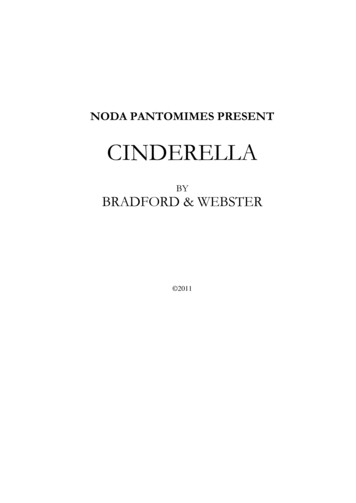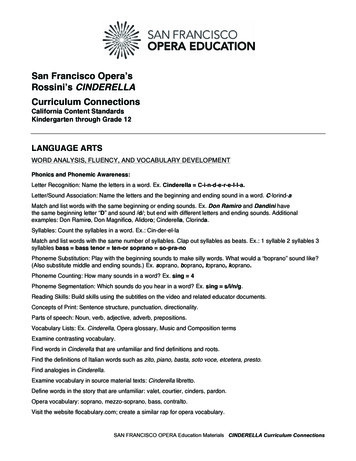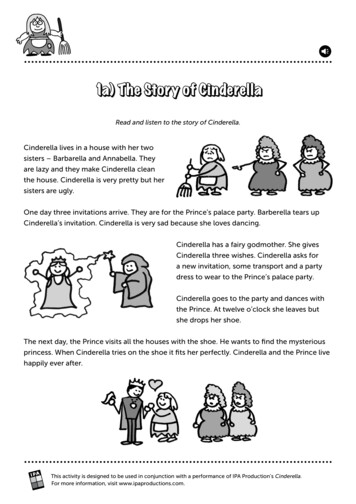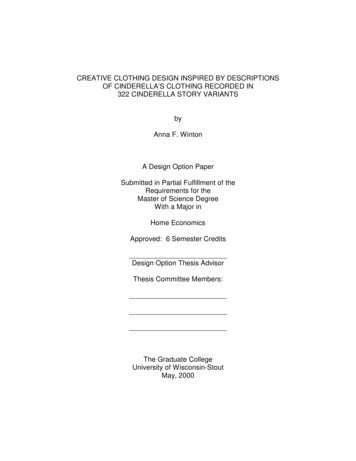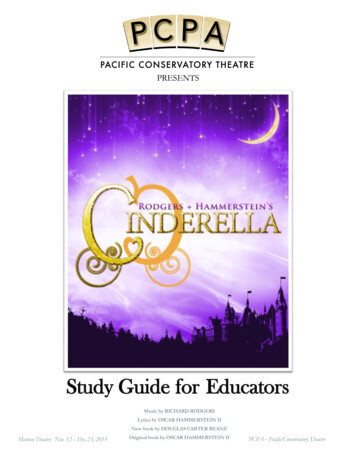
Transcription
PRESENTSStudy Guide for EducatorsMusic by RICHARD RODGERSLyrics by OSCAR HAMMERSTEIN IINew book by DOUGLAS CARTER BEANEMarian Theatre: Nov. 12 – Dec. 23, 2015Original book by OSCAR HAMMERSTEIN IIPCPA – Pacific Conservatory Theatre
Table of ContentsWelcome to PCPA/Theater Etiquette .3How to Use This Guide . 4Production Team and Cast .5Elements of the StoryPlot Synopsis 6Themes and Key Words .8A History of Fairytales . 9Elements of the ProductionAbout the Authors . 10About the Production .11Design Concept 12ActivitiesDiscussion Questions .13Preshow Games .14Ruling the Kingdom Game .15Coloring Castle .162
Welcome to the Royal Palace at PCPAA NOTE TO THE TEACHERThank you for bringing your students to PCPA at Allan Hancock College. Here are some helpful hints foryour visit to the Marian Theatre and our Royal Ball. Our top priority is to provide an enjoyable day of livetheater for you and your students. We offer you this study guide as a tool to prepare your students prior tothe performance, and to prompt discussion, critical thought, and creativity before and after the performance.ETIQUETTE FOR YOUNG LORDS AND LADIES ATTENDING THE BALLNotable behavior is a vital part of theater for youth. Going to the theater is not a casual event. It is a specialoccasion. If students are prepared properly, it will be a memorable, educational experience they willremember for years.1. A royal chaperone should always be with the students. Ushers are available to help with seating. Wesuggest that teachers sit in between students to help maintain order during the palace festival.Remember, courtiers in waiting must always be accompanied by an experienced adult!2. Please remind our special invitees that we do not permit:food, gum, drinks, smoking, hats, backpacks, or large pursesdisruptive talkingdisorderly and inappropriate behavior (stepping on/over seats, throwing objects, etc.)cell phones or any other recording devicesLight up or noise making objects (including shoes)(Adults are asked to put cell phones on silent or vibrate)3. Before attending the show, teachers should take time to remind students of the following about a liveperformance:Sometimes we forget when we come into a theater that we are one of the most importantparts of the production. Without an audience there would be no performance. Yourcontribution of laughter, quiet attention, and applause is part of the play. When we watchmovies or television we are watching images on a screen, and what we say or do cannotaffect them. In the theater the actors are real people who are present and creating anexperience with us at that very moment. They see and hear us and are sensitive to ourresponse. They know how we feel about the play by how we watch and listen. An invisiblebond is formed between actors and a good audience, and it enables the actors to do theirbest for you. A good audience helps make a good performance.PCPA welcomes you as a partner in the live theater experience from the moment you take your seats.We hope that your visit will be a highlight of your school year3
HOW TO USE THIS GUIDEThis study guide is a companion piece designed to explore many ideas depicted in the stage production ofRodgers and Hammerstein’s Cinderella (2013 revival). Although the guide’s intent is to enhance the student’stheatrical experience, it can also be used as an introduction to the elements of a play and the productionelements involved in the play’s presentation. While many students are familiar with a variation of the storyCinderella in pop culture, this specific stage adaptation offers a fresh perspective on the tale of the underdog.It inspires conversation about community and symbiosis in a contemporary world characterized by divisionand hostility.The guide has been organized into three major sections:Elements of the StoryElements of the ProductionActivitiesTeachers and group leaders will want to select portions of the guide for their specific usage. The discussionquestions provided are meant to provoke a line of thought about a particular topic. Frequently, the answers tothe questions will initiate a process of exploration and discovery of varied interpretations sometimes deviatingfrom original ideas. It is recommended that these thoughts be encouraged and discussed. This can be asinsightful and rewarding as the wonderful experience that Rodgers and Hammerstein’s Cinderella creates onstage.Outside resources from literature and pop culture are a wonderful way to make learning immediately relevantto everyday life. Listed below are a variety of materials which can be used in conjunction with lesson plansand the discussion of the theatrical elements and themes of the stage production:Films: Cinderella (1950), the animated film produced by Walt Disney. Rated G. This is the most popularfilm adaptation of the story. Take a moment to compare the difference between how Cinderellagains opportunity in this version versus earning it in the stage adaptation. Ever After (1998), the live action film directed by Andy Tennant. Rated PG-13. This version is setin 16th-century France and closely mirrors the version of story depicted in the stage adaptation.Books: Cendrillon by Charles Perrault, published in 1697. This is the first time a fairy godmother, glasssippers and magic pumpkins appear in a version of the story. English translations are in thepublic domain and available for free online. Aschenputtel by the Brothers Grimm, published in the 19th century. A wonderful telling that canbe used to introduce the concept of Fairy Tales, collectors of folklore, and the internationalscope and versions of the Cinderella story. English translations are in the public domain andavailable for free online.Note: Egyptian, Greek, and Native American versions of Cinderella can also be found and used in coursework.4
Music by RICHARD RODGERSLyrics by OSCAR HAMMERSTEIN IINew book by DOUGLAS CARTER BEANEOriginal book by OSCAR HAMMERSTEIN IICREATIVE TEAMDirector/ Choreographer Michael JenkinsonMusic Director Brad CarrollVoice & Text Director Andy PhilpotScenic Design Jason BolenCostume Design Eddy BarrowsLighting Design Jennifer ‘Z’ ZornowSound Design Elisabeth WeidnerAssistant Director Nicholas KowerkoAssistant to the Choreographer Alex StewartProduction Stage Manager Jahana Azodi*Stage Manager Ellen BeltramoCAST OF harlotteJean-MichelLord PinkletonGiantMolly WetzelJordan StidhamKitty Balay*Peter Hadres*Elizabeth Stuart*Karin HendricksAnnali FuchsMatt KoenigSpencer HamiltonErik Stein*ENSEMBLEGeorge Walker, Alex Stewart, William Hoshida, Zach Johnson, David Miller, Blake BrundySierra Wells, Courtney Reece, Natalie Graham, Catherine Evangelho, Libby Hawkins, Brittany LawMAGIC ENSEMBLEJulia Towers, Jenny Nelson, Madeline Moeller, Ari Lagomarsino, Quinn FarleyGarrett Gibbs, Tux Johnson, Devin Cunningham* Member, Actors’ Equity Association5
“CINDERELLA”: A SYNOPSISACT ONE:Once upon a time, in a forest far away livedELLA, a young woman who dreams of abeautiful and kind world while doing chores forMADAME, her stepmother (The Hills Are EveryShade of Yellow). On the other side of thekingdom, PRINCE TOPHER has defeated agiant in battle. Despite his success and hisupcoming coronation to the kingship, hestruggles to find his purpose in life (Me, WhoAm I?). Prince Topher comes upon Ella in theforest and is impressed by her friendliness to ahomeless woman named MARIE. Politicalactivist JEAN-MICHEL arrives to share hisnewest ideas about the problems between theMolly Wetzel as Ella and Jordan Stidham as Prince Topherrich and poor just as the Prince and his partyare heading back to the palace. When Madame and her daughters, GABRIELLE and CHARLOTTE, returnfrom shopping, Jean-Michel offers a book to Gabrielle, whom he secretly loves. Madame quickly rejects thebook, causing Jean-Michel to give it to Ella instead. With the stories, and the help of her imagination, Elledreams of life beyond her rags (In My Own Little Corner). Back at the palace, preparations are made to host aball to find Prince Topher a wife (An Announcement). The prominent members of society are excited about theball (The Prince is Giving a Ball), but Jean-Michel gathers the poor to stand up for themselves (Now is the Time).Marie watches all the chaotic excitement from a distance while talking to herself (Folderol). The LordChancellor, SEBASTIAN has a private audience with Madame to plan for Gabrielle and the Prince to marry.Madame throws Jean-Michel out when he calls with flowers for Gabrielle. After everyone leaves and starts forthe ball, Marie magically reveals herself as Ella’s Fairy Godmother and begins the process of getting Ellaready for the ball. Marie magically transforms the world around her into royal attendants, a pumpkin carriage,and glass slippers, proving to Ella that practically anything is possible (Impossible / It’s Possible)! Donning hernew outfit, Ella is unrecognizable as she arrives tothe ball just as it is beginning. The attendees areplaying a royal game, “Ridicule,” where complaintsand insults are hurled at each other. Ella andMadame match off and everyone is surprised whenElla compliments Madame. Enamored by theconcept of kindness, the castle fills with warmth andjoy. Prince Topher immediately becomes infatuatedby this beautiful stranger (Ten Minutes Ago). The belltolls twelve as they are about to kiss. In haste, Ellatells the Prince of many people suffering in hiskingdom and pleads with him to help establishpeace. Ella leaves, dropping one of her glassslippers.6
ACT TWO:Prince Topher organizes hisguard in an effort to search forElla (The Pursuit). Charlotte, leftat the palace, is distraught (TheStepsister’s Lament). Madame andher daughters finally returnhome and discuss the evening.Ella shares how she “imagined”the evening (When You’re DrivingThrough the Moonlight). All thewomen of the house join Ella inher dream about true love(Lovely Night). Night falls andMadame and Charlotte go tobed. Alone, Gabrielle showsElla that she is sympathetic toMolly Wetzel as Ella and Kitty Balay as Madameher. They tell each other whatno one else knows: that Ella was the stranger at the ball, and that Gabrielle loves Jean-Michel. Stumped in thechase, Prince Topher has returned frustrated to the palace (Loneliness of Evening). He demands that a grandbanquet must be prepared in order to find Ella. Madame hears of the feast and returns to the cottage getready with her daughters. Gabrielle wants to help Jean-Michel serve the poor in the soup kitchen, so shepretends to be sick and offers her dress for Ella to wear tothe banquet. Jean-Michel comes to get Gabrielle afterMadame and Charlotte have left, but is discovered byMadame who has returned home. She throws Gabrielle outof the house and shreds the borrowed dress Ella is wearing.Marie finds Ella and inspires her to believe in herself (There’sMusic in You). Once more, Marie turns Ella’s ripped dressinto a beautiful ball gown and sends her to the banquet. Ellaand Prince Topher are reunited at the palace and she tellshim that the poor will be coming. After the Prince listens tothe concerns of the poor of his land, he is moved to hold anelection for the first Prime Minister of the land. Witheveryone abuzz and eager about the new changes in thekingdom, Prince Topher and Ella think about their romance(Do I Love You Because You’re Beautiful?), but again the clockstrikes twelve sending Ella running away and leaving herslipper behind. The kingdom is busy the next day with theelection and search for Ella. Prince Topher puts the slipperon many a lady’s foot with no success in finding a perfectmatch. When the slipper fits perfectly a poor girl in raggedclothes, he is overjoyed to see discover it is Ella! Heproposes on the spot and announces the winner of theelection. Everyone lives happily ever after.7
THEMES from CINDERELLA– ADVOCACY –Sometimes it is necessary for one person to represent and become the voice of many people who aren’t beingthought about or listened to. Ella gains the favor of the Prince because she speaks so openly about theproblems the poor experience in the kingdom. Jean-Michel becomes an advocate for the people of the lowerclass and expresses their discontentment with the way they are treated. Because they speak out, changes aremade in the land, and an atmosphere of kindness unifies the people.– TRANSFORMATION –The desire to change and be “made over” is a universal experience shared across cultures. Can you recall whatyou wanted to be when you grew up, even if it seems/seemed impossible at the time? Ella becoming aprincess or having her peasant dress made into a beautiful ball gown is perhaps the most enjoyable emotionalexperience of the show. She has beaten the odds. The Prince has a second chance to become the ruler whobrings good to the land. Transformation doesn’t require a magic wand, but it does mean putting a great dealof effort into creating change. It’s possible!– OPPRESSION –Sebastian wants to keep his position of authority and power. To do so, he keeps secrets from Prince Topherabout how he is ruling the kingdom and using the citizens for his own personal gain. Dishonesty andpropaganda are tools Sebastian uses while falsely appearing loyal and kind. Rather than setting the example asa good leader who guides and does what is best for the people, he only thinks about himself and causes otherpeople pain.– KINDNESS –Ella sets in motion the concept of betterment and change throughout the kingdom when she is kind to Marieand to Madame at the ball. People see the way she offers kindness and they like how it feels to be treated inthis manner. In turn they begin to “change” as they embrace the act of kindness, until even the Prince ismesmerized by its power. True leadership isn’t found in how much control someone has, but in how theytreat and care for others who in return follow her/his example.KEYWORDSMAGIC: a mysterious orsupernatural force and power.BALL: a formal dance.ROYALTY: a person who isfrom a bloodline of rulers.ELECTION: an eventwhere citizens get to vote for arepresentative.FAIRY GODMOTHER: aguardian who is protecting andlooking out for someone.STEPSISTER: a sister who isa result of marriage but hasdifferent parents.CLASS: a characteristic whichindicates someone’s wealth.PALACE: the fancy home ofthe ruler.KINDNESS: a friendly,generous or considerate act.LONELINESS: a feeling ofisolation or lack of purpose.RADICAL ACTIVIST: anindividual who has ideas fordramatic change.8
THE BEGINNING OFONCE UPON A TIME Once upon a time, someone began telling the first fairytale. But nobody knows for sure when that happened!A fairytale or fairy-story typically draws from folklore and contains elements of magic or mythical creatureslike dragons, fairies, dwarfs, elves, gnomes, trolls, witches, etc. What sets fairytales apart from any other storyis that fairytales have a moral or message. These stories have been passed down orally for thousands of years;for example, when someone tells a bedtime story from memory. In 17th-century France, a lady namedMadame d'Aulnoy was one of the first to write these stories down and coined the term "Fairytales" whichgrew to become the genre of literature it is today.CHARLES PERRAULT (1628-1703)Another man was writing down folk tales in France as the fairytale genrewas emerging on the literary scene. Charles Perrault is credited for penningstories that have become very familiar today: Le Petit Chaperon rouge (LittleRed Riding Hood), La Belle au bois dormant (The Sleeping Beauty), Le ChatBotté (Puss in Boots), and of course, Cendrillon (Cinderella). Perrault gavereaders glass slippers, magical pumpkins, and a fairy godmother for the firsttime. Some of his stories came from a collection called Tales and Stories ofthe Past with Morals (Histoires ou Contes du Temps passé), which are subtitledand seen as the beginning of the "Mother Goose" stories. After resigningfrom the Académie française, he dedicated his life to his children and wrotestories for them. His work and legacy have in turn affected the entireWestern world.THE BROTHERS GRIMMJacob and Wilhelm Grimm, commonly known as “the BrothersGrimm,” popularized and increased the fairytale canon of literaturethroughout Germany in the 1800s. As professors they created thefield of German studies during the German Romantic period. Manyfairytale authors influenced the Brothers Grimm, including the workof one Charles Perrault. The brothers specialized in folklore andwould travel to collect stories from people of all classes: peasants tokings. Their work was well received as the culture turned their interesttoward nature, a subject Jacob and Wilhelm readily supplied.Consequently, their version of Cinderella (Aschenputtel) focuses a loton the forest and even has Cinderella finding help andencouragement in a wishing tree rather than a fairy godmother. Overtheir lifetime they published multiple collections of fairytales andsongs which they continued to revise until their death. Some of the most famous stories include Snow Whiteand the Seven Dwarfs, Rapunzel, Hansel and Gretel, and Aschenputtel. The Brothers Grimm have had their workstranslated into more than 100 different languages and adapted as the foundation for many books, televisionprograms, radio shows, and theater performances. Their far reaching hand shows how fairytale themes of canbe universally resonant.Did you know that fairytales were originally written for both adults and children?9The association between children and fairytales grew stronger when the BrothersGrimm entitled their collection "Children's and Household Stories."
MAGICIANS AND MUSICIANS:RODGERS AND HAMMERSTEINRichard Rodgers and Oscar Hammerstein II, oftenreferred to as Rodgers and Hammerstein, areconsidered the greatest musical theatre writing duoof the 20th century. Both Rodgers andHammerstein attended Columbia College and,along with fellow undergraduate lyricist LorenzHart, first collaborated on the 1920 VarietyShow: Fly With Me. After college, Rodgers found success on Broadway with Hart early in their careers withover 20 shows including the well-known Babes in Arms and Pal Joey. Hammerstein also became well known inNew York due to his work with Jerome Kern on musicals such as Show Boat. Hart's health went into declineand Rodgers turned to Hammerstein for help with a musical adaptation of Green Grow the Lilacs. This firstcollaboration became the timeless production, Oklahoma!. The success turned into 34 Tony Awards,15 Academy Awards, 2 Pulitzer Prizes, and 2 Grammy Awards. Their cannon of work featuring thetitles Carousel, South Pacific, The King and I, The Sound of Music, and of course Rodger and Hammerstein's Cinderella isiconic of the 1940s and 1950s, the era known as the "Golden Age" of musical theatre. On the surfaceRodgers and Hammerstein's shows are very lighthearted, but the partnership challenged the expectation formusical theatre to be comedic by addressing social issues such as classism, racism, sexism, and domestic abusein their stories. Although both partners have now passed away, their legacy continues to influence notabletheater composers today, a couple examples include Lin-Manuel Miranda and Stephen Sondheim.Douglas Carter Beane is a playwright and screenwriter who was challenged with adapting the traditionalversion of Rodgers and Hammerstein’s Cinderella to a full length Broadway show for a contemporary audience.His other work includes The Nance, The Little Dog Laughed, As Bees in Honey Drown, the musicals Xanadu, SisterAct, Lysistrata Jones, and Rodgers and Hammerstein's Cinderella (2013 BroadwayProduction). Beane has been nominated for multiple Tony Awards and is thepresent artistic director of the Drama Dept. Theater Company. He also wrotethe film To Wong Foo, Thanks for Everything, Julie Newmar. He lives with hispartner Lewis Flinn and two children, Cooper and Gaby.10
Elizabeth Stuart as Marie and Molly Wetzel as EllaABOUT THE PRODUCTIONThis new reconceived version of Cinderella by Douglas Carter Beane expands on the original Rodgers andHammerstein classic musical yet retains its timelessness in a tale where dreams really do come true. In thisversion Cinderella is a very smart, independent, woman, who's socially conscious. The prince falls in love withher not just because she's a beautiful young lady, but because of her integrity and her awareness of what'sgoing on in his kingdom. In fact, she empowers him to start taking control of what's going on.The reason Cinderella has been so popular so long is because of the beautiful Rodgers and Hammersteinscore, and with the refreshed orchestrations and new added pieces of music from the R&H catalogue, andnew book, the show is much more appropriate for a contemporary audience. PCPA is one of the firstregional theatre companies to do this version, so it will be very much the PCPA production of Cinderella. Itwill certainly honor the authors' intentions, but the design will be very original.The scenery will take us from opulent castle to thatched houses and forests. And, because it is a fairy tale,with no set time in history the costume designer has the freedom to create his own sense of time andsilhouette, other than the requisite costume requirements as dictated by the script. TheDirector/Choreographer promises that the finished production will simply be magic before your eyes.11
DESIGN CONCEPTDesigners have different ways of approaching their role in storytelling. In this particular situation, it has beenthe Designer’s hope that the set does not stand out to the audience but rather complement and harmonizewith the other aspects of the production. Read the paragraphs below and compare it to what you see onstage. Can you see how these concepts appear on stage?Setting: Fairytale forests can be so many things; mysterious, romantic, and even dangerous. Cinderella’s forestwas created to incorporate all those feelings and bring the different locations of the story to life. Magic comesfrom the nature found in Ella’s backyard. Her best friends are the woodland creatures that become thecoachman and footman, and the mysterious woman who lives in the forest is revealed to be her guardianspirit. In her life of unjust cruelty, the simple and unexpected things become the most powerful. Magicalthings are designed to look similar to nature. (Pay close attention to Ella’s golden carriage that looks like apumpkin and the horses resemble the design of the trees).Color: Colors were chosen that would enhance the story and also bring the beautiful Roger and Hammersteinscore to life. The Designer used clues they could find in the lyrics of the lush and vibrant score. The openingsong talks about the appearance of the kingdom: “the fields are aglow in autumn yellow.” Since the talebegins in fall, a color palate was chosen to match the rich images of fall and the tone found in the music.Shapes: Peasant life and the world of the aristocracy is looks different because of shape. This is a veryimportant distinction the Designer set out to establish. The setting for the Palace and Royal functions takeson a smooth stone look. This contrasts more natural and circular settings of the dwellings belonging topeople like Ella or Jean-Michele.A Note from the Costumer: A Collective MemoryCinderella is one of those Collective Memory pieces. To explain that statement; our Collective Memory tells us thatblue and yellow make green, that good guys wear white and bad guys wear black. Our Collective Memory remindsus of the smell of strawberries when we see a picture of strawberries, and when we hear the word "witch," ourmemory reminds us of pointy black hats and green skin.I threw away all my Collective Memory of Cinderella. I started scribbling on white pages in a bound sketchbook.Almost immediately, our collective of designers arrived at an autumn color palette. Crisp, frosty morningspunctuated with a harvest of golden, burnt-orange and red leaves falling from a glycerin blue sky. In my mind,autumn is a "spice" most of us savor.I took several morsels from the artist/illustrator Maxfield Parrish, daubed on a dollop of Marie Antoinette's lavishaffections for sugary delights, pinched a smidge from fairytale illustrator Arthur Rankham, sprinkled a smatteringof actual costume history, and then stirred it all into the ratatouille you see on stage.12
DISCUSSION QUESTIONS:1. Leaves, trees, animals, and life abound on this stage! What is Cinderella’s connection to nature? Howdoes her awareness of the world around her help her open the eyes of the kingdom to the life andpeople around them?2. Why is Madame so determined to have one of her daughters marry the Prince? Prince Topher haslots of money but is still unhappy and confused. Do you think money makes people happy?3. There is a lot of conflict throughout the kingdom. The royals battle the giants. The poor are unhappyand mistreated by the upper-class. Is there peace in the kingdom at the end of the play? Do you thinkthis peace will last? Is there an event from history that closely mirrors the unrepresented citizensshown in Cinderella?4. Everyone is human and makes mistakes—even the people we look up to the most. What mistakes doElla, Prince Topher, Jean-Michel and the other heroes of this story make? Is it okay becauseeverything ends up alright in the end? What steps should happen after anyone messes up?5. At first Ella believes it is “Impossible” for her to go to the ball. But when Marie shows her the wayand she steps out in faith, it suddenly becomes “Possible!” Can you think of a situation wheresomeone had to believe they could do something and had to step out in faith? Is there a time in yourlife you had to do that? If taking a shot ends in failure, is it still worth it?6. Charlotte and Ella have a sort of sibling rivalry while Gabrielle is vulnerable and becomes close withElla. Is the conflict in the story a bad thing? Is there conflict in your family or community? Is there away to successfully handle conflict bring peace?7. How is this version of Cinderella different from other ones you are familiar with? Does it change themeaning of the story?8. Look up a version of Cinderella from another culture: China (Yeh-Shen), Egypt (Rhodopis), Russia(Vasilissa the Beautiful). What can you learn about what these cultures value? What makes a heroine?Who is a modern day heroine?Here are some links to a few versions of Cinderella!1. Yeh-Shen: ons8980.html2. Rhodopis: http://www.egyptianmyths.net/mythslippers.htm3. Vasilissa: 13
MARIE’S MAGIC TRANFORMATION:PRESHOW ACTIVITYDid you know that Oscar Hammerstein II was studying to become a lawyer when he dropped out of schoolto start writing for theatre? Walt Disney worked as an editor at a newspaper and was fired because he "lackedimagination." Both of these individuals are partially responsible for making Cinderella what we know it istoday. Stories of personal and career transformation exist in many industries and cultures. Steve Jobs,Founder and former CEO of Apple Inc. quit the computer industry to move to India and study Buddhism.He later returned and built Apple Inc. into what it is today.It is never too late to pursue a new goal or career. Take some time and have students research a fictionalcharacter or historical figure that transformed and then share their findings with the class! Make sure to lookclosely: good stories always transform or change their character in some way, it's called an arc or innerjourney. Here are some examples to get you started:- Elsa from Frozen- The Ugly Duckling- Lucille Ball- The BeatlesBEAUTIFUL, BECAUSE I LOVE THEMIn some accounts of popular Fairytales, the pretty Princess meets the charming Prince, and they fall in love tolive happily ever after. Well that seems a little superficial to build a long lasting relationship. The 2013Broadway production of Rodgers and Hammerstein's Cinderella has Prince Topher realizing his attraction to Ellaafter she confronts him about the problems dividing the people. It is Ella's character: her mind, heart,kindness, and genuine care for others that puts the Prince under her spell. During the song Do I Love YouBecause You're Beautiful, Ella and the Prince come to the conclusion that their inner love and care for eachother is more important than what someone looks like on the outside.Think of somebody you know who is truly beautiful. Maybe their inside joy, happiness, and love shines onthe outside. Maybe it is your parent or a close friend. Take a moment to write down a few things that makethis person beautiful, and then draw a picture of what that looks like.CHARACTERISTICSPICTURE14
RULING THE KINGDOMThere are a variety of systems of government that exist throughout the world and in the world of Cinderella.Here are some definitions of a few.Democracy: a governmentwhere everyone has theopportunity to choose leadersor gets a say in how things aredone through a system ofvoting.Socialism: a system where thegovernment owns productionand has charge of thedistribution of goods with thegoal of everyone having thesame rights.Monarchy: the Head of State,such as a king or queen, hasthe power to make decisionson behalf of his/her citizens.All three of these systems are present in Cinderella in some way. Read the next descriptions and see if you canmatch them to the definitions of government above!1. Jean-Michel talks to Ella about the unfair treatment of the poor people. He believes that they should havethe same rights and things as the upper-class. This would be a g
Cinderella (1950), the animated film produced by Walt Disney. Rated G. This is the most popular film adaptation of the story. Take a moment to compare the difference between how Cinderella gains opportunity in this version versus earning it in the stage adaptation. Ever After (1998), th

